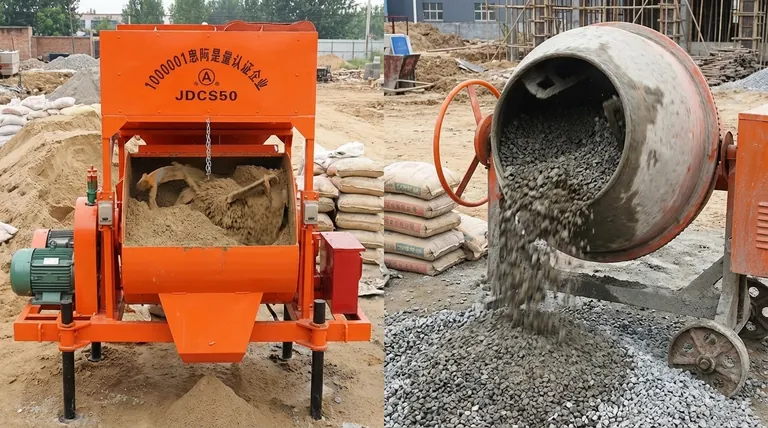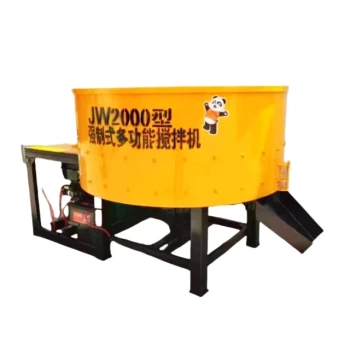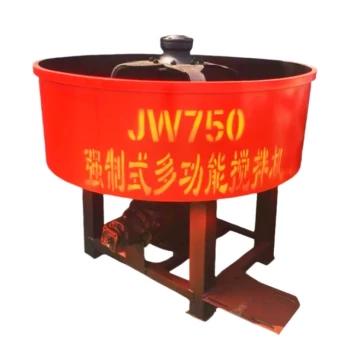At first glance, they seem interchangeable, but the difference between a mortar mixer and a cement mixer comes down to their mixing action and the materials they are designed to handle. A mortar mixer uses fixed paddles to churn and blend materials in a stationary tub, whereas a cement mixer uses a rotating drum to tumble and fold them. Using the wrong machine can lead to a poor-quality mix and potential equipment damage.
The core distinction is not the name but the aggregate involved. Mortar mixers are for fine aggregates like sand, while cement (or concrete) mixers are built to handle the heavy, coarse aggregates like gravel found in concrete.

The Core Difference: Mixing Action and Material Design
The fundamental design of each mixer is engineered for a specific type of material. This difference is most apparent in how they achieve a consistent mixture.
How a Mortar Mixer Works: Paddles
A mortar mixer, often called a "paddle mixer," functions like a large stand mixer for construction materials.
It has a stationary barrel with paddles inside that rotate on a central shaft. This creates a churning, shearing action that is perfect for blending fine materials like sand, cement, water, and lime into a smooth, consistent paste.
How a Cement (Concrete) Mixer Works: Drum
A cement mixer, more accurately called a concrete mixer, uses a large, rotating drum.
As the drum spins, internal fins lift the material to the top and then let it tumble back down. This action is crucial for keeping heavy, coarse aggregates like gravel suspended and evenly distributed throughout the mix.
Why the Material Dictates the Machine
The presence or absence of heavy gravel is the deciding factor.
Mortar has a high ratio of cement and sand, requiring a forceful shearing action to ensure the cement paste completely coats every grain of sand.
Concrete relies on the tumbling motion to prevent the heavy gravel from settling at the bottom, which would create a weak, inconsistent final product.
Understanding the Trade-offs and Critical Risks
While they both mix construction materials, using one in place of the other comes with significant consequences, especially when misused for concrete.
Can You Mix Mortar in a Cement Mixer?
Yes, but it's inefficient. The gentle tumbling action is not ideal for the shearing required to create a perfect mortar consistency. The material may slide more than mix, potentially resulting in an uneven blend.
Can You Mix Concrete in a Mortar Mixer? (The Critical Mistake)
This should be avoided at all costs. A mortar mixer is not designed to handle concrete.
The paddles lack the ability to lift and fold the heavy gravel. The aggregate will sink, the sand and cement will separate, and the resulting mix will be useless.
Furthermore, the lower-power motor on a mortar mixer will strain against the weight of the concrete, leading to overheating and potential burnout. The paddles can also get stuck and break.
Making the Right Choice for Your Project
Choosing the correct mixer is simple once you identify the aggregate in your material. This ensures material integrity and protects your equipment.
- If your primary focus is bricklaying, block work, stucco, or tile grout: You are working with mortar and need a mortar mixer for its superior blending of fine materials.
- If your primary focus is pouring footings, slabs, or setting posts: You are working with concrete and must use a cement (concrete) mixer to properly handle the heavy gravel.
Matching the machine's action to the material in your mix is the key to a successful project.
Summary Table:
| Feature | Mortar Mixer | Cement (Concrete) Mixer |
|---|---|---|
| Mixing Action | Fixed paddles churn and shear | Rotating drum tumbles and folds |
| Designed For | Fine aggregates (e.g., sand) | Coarse aggregates (e.g., gravel) |
| Ideal For | Bricklaying, stucco, tile grout | Footings, slabs, posts, foundations |
| Risk of Misuse | Motor burnout, broken paddles | Inefficient, uneven mix |
Ensure Your Project's Success with the Right Equipment
Choosing the correct mixer is critical for achieving a high-quality mix and protecting your investment in machinery. GARLWAY specializes in providing durable and efficient construction machinery, including mortar mixers and concrete mixers, designed specifically for the demands of construction companies and contractors.
Let our experts help you select the perfect mixer for your needs. We can guide you to the right solution for bricklaying, concrete pouring, or any other project requirement.
Contact GARLWAY today for a consultation and get a quote on the machinery that will power your success.
Visual Guide

Related Products
- JDC350 Small Cement Concrete Mortar Mixer
- Auto Concrete Cement Mixer Machine New
- Commercial Construction Mixer Machine for Soil Cement Mixing Concrete
- Construction Products Concrete Plant Machine Mixing Concrete Mixer
- Portable Electric Concrete Mixer Machine for Cement Mixing
People Also Ask
- How much does a portable concrete mixer hold? A Guide to Choosing the Right Capacity
- Is there a difference between a concrete mixer and a mortar mixer? Choose the Right Machine for Your Project
- How to choose the right concrete mix? A Guide to Balancing Strength, Workability, and Cost
- Can you mix mortar in a cement mixer? Avoid weak joints and project failure.
- Can a concrete mixer be used for mortar? Understanding the trade-offs for your project



















